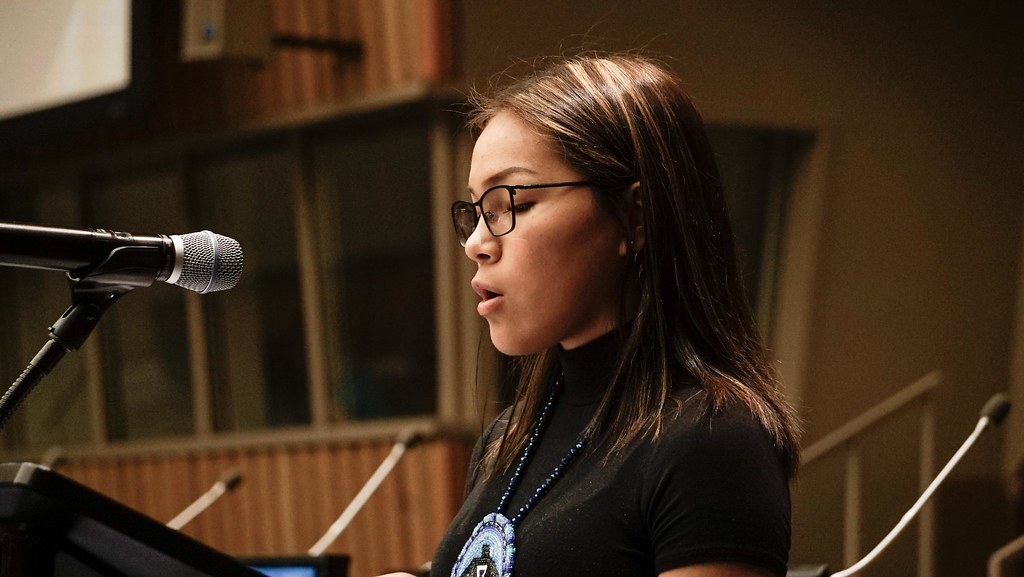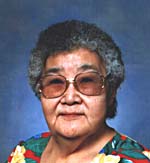An activist is someone who works to bring about social or political change. Many Indigenous people in Canada have been at the forefront of movements that concern issues like the environment, Indigenous and treaty rights, equal access to education and health care, the rights of women and children, and more. Indigenous women have taken up causes that affect their families and communities. This article names some of the many Indigenous women activists in Canada who have effectively championed important causes. (See also Indigenous Women’s Issues in Canada.)
1. Bertha Clark Jones (born 6 November 1922, died 21 October 2014; Cree-Métis)

Bertha Clark Jones grew up on an Alberta farm. In 1940, she enlisted in the Royal Canadian Airforce and was soon a corporal, travelling to air bases to train air squadrons. (See also RCAF Women’s Division.) At the war’s conclusion she joined the Aboriginal Veterans Society, advocating for the rights of Indigenous veterans. (See also Indigenous Peoples and the World Wars.)
In Fort McMurray, Jones created the friendship centre Nistawoyou to help Indigenous people find work. She also created New Start, an organization to help Indigenous people upgrade their education. In 1968, Jones co-founded the Voice of Alberta Native Women’s Society (VANWS) that helped Indigenous women fight for rights denied by the Indian Act. In 1974, the VANWS became the Native Women’s Association of Canada and Jones was its first president.
2. Autumn Peltier (born 27 September 2004; Anishinaabe)

When growing up on the Anishinabek Territory on Manitoulin Island, Autumn Peltier learned from her mother and aunt (Josephine Mandamin), who were also political activists, that remaining silent about an injustice is not an option. When only 12-years-old, Peltier began speaking out about the importance of access to clean drinking water that was being denied to far too many Indigenous communities. She met with Prime Minister Justin Trudeau and bluntly told him that he was not doing enough to address the problem. She addressed the United Nations Landscapes Forum and said that decision-makers needed to understand that we can’t eat money or drink oil. At age 14, she became the chief water commissioner for the Anishinabek Nation, which represents 39 First Nations in Ontario. Three years in a row, beginning in 2017, she was nominated for the International Children’s Peace Prize.
3. Helen Mamayaok Maksagak (born 15 April 1931, died 23 January 2009; Inuvialuit)

Helen Mamayaok Maksagak was born on the land near Bernard Harbour. In the 1960s and 1970s, she managed an Outreach Centre for the Royal Canadian Mounted Police. She also completed service work on various committees, including the Drug and Alcohol Board, Housing Association Board, Social Assistance Appeal Committee, and Northwest Territories Round Table on the Environment.
Maksagak was the deputy commissioner of the Northwest Territories and then commissioner; the first woman and first Inuk to hold the position. (See also Territorial Government in Canada.) In 1999, she became commissioner of the newly created Nunavut. She also served on the Nunavut Status of Women Council, on the Board of the Aboriginal Healing Foundation, and, in 2005, as Nunavut’s deputy commissioner. She consistently supported those in the north who wanted to live according to their ancestral lifestyle.
4. Jean Cuthland Goodwill (born 14 August 1928, died 25 August 1997; Cree)

Jean Cuthand Goodwill was raised on the Little Pine First Nation. In 1954, Goodwill became Saskatchewan’s first Indigenous nurse, often travelling by dog sled or bush plane. She became the executive director of Winnipeg’s Indian and Métis Friendship Centre.
In 1965, she advocated for Indigenous health as a member of the Department of Indian Affairs and Northern Development. In 1974, Goodwill co-founded and, from 1983 to 1990, was president of the Indian and Inuit Nurses of Canada (later the Canadian Indigenous Nurses Association). She was the first Indigenous woman to advise the Minister of National Health and Welfare (now Health Canada) in 1981. (See also Indigenous Services Canada.) Goodwill helped create the University of Saskatchewan’s Community of Aboriginal Nursing and was the Indigenous Health Studies department head at the First Nations University of Canada. She was also president of the Canadian Society for Circumpolar Health.
5. Cindy Blackstock (born 1964; Gitxsan First Nation)

Born in Burns Lake, British Columbia, Blackstock earned her BA at the University of British Columbia, two Masters degrees from McGill and Loyola University Chicago, and a PhD in social work from the University of Toronto. She published over 75 articles outlining the complex problems and sensible solutions regarding Indigenous children’s rights. In 2007 she launched a case against the federal government, accusing it of systemically denying Indigenous children the same quality of service as non-Indigenous children. (See also Jordan’s Principle.) The Canadian Human Rights Tribunal first ruled in her favour in 2016 but the government has appealed certain parts of that and subsequent rulings, so negotiations are continuing. As a professor at McGill University’s School of Social Work and Executive Director of the First Nations Child and Family Caring Society, Blackstock continues to advocate for and bring about real change to improve the lives of Indigenous children.
6. Sheila Watt-Cloutier (born 2 December 1953; Inuk)

Sheila Watt-Cloutier was born in a small Inuit community of Fort Chimo, now called Kuujjuaq, in northern Quebec. She spent years in the south before returning north to find too many communities and families devastated by addictions, poverty, and substandard education. She dedicated herself to finding solutions. In 1990, she was elected corporate secretary of the Makivik Corporation which administered money from the James Bay and Northern Quebec Agreement. She was elected Canadian president of the Inuit Circumpolar Council and then its international chair from 1995-2006. Her advocacy for Indigenous peoples and solutions to climate change earned her a 2007 Nobel Prize nomination. Her award-winning memoir,The Right to be Cold: One Woman’s Story of Protecting Her Culture, the Arctic and the Whole Planet, told of her life and struggle for social, political, and environmental justice.
7. Lorelei Williams (born 1980; Skatin and Sts'ailes First Nations)
Lorelei Williams’ aunt disappeared over 40 years ago, and her cousin was missing until it was discovered that she had been murdered in 1996. The tragedies inspired Williams to become an influential voice in the movement to address missing and murdered Indigenous women and girls. To raise awareness and empower young Indigenous women, she formed a dance group called Butterflies in Spirit that performs across Canada. She volunteers for the Missing and Murdered Indigenous Women Coalition which brings together 25 urban communities and political advocacy groups. Williams was also the woman’s coordinator at the Vancouver Aboriginal Community Policing Center, promoting dialogue between Vancouver Police and Indigenous communities. She became the program manager at the Restoring Circles Society, helping those healing from trauma.
8. Jessica Gordon (Saulteaux/Cree), Sylvia McAdam (Cree), Nina Wilson (Nakota and Plains Cree) and Sheelah McLean (settler raised on Treaty 6 territory)
In late 2012, the federal government introduced Bill C-45. It proposed a great number of legislative changes that included removing protection for waterways through Indigenous land, weakening treaty rights, environmental protection laws, and the ability of Indigenous communities to control their land. Four women from Saskatchewan – Jessica Gordon, Sylvia McAdam, Nina Wilson, and Sheelah McLean – decided to fight C-45. They started by creating a Facebook page called Idle No More. This became the name of the movement. Soon, the women were organizing and inspiring rallies, protests, and blockades across Canada. They moved far beyond C-45 as they encouraged Indigenous voices to speak up and demand fundamental justice and respect for Indigenous people and sovereignty. Each of the women are also individually involved in other avenues of political action.
9. Elsie Knott (born 20 September 1922, died 3 December 1995; Anishinaabe)
In 1951, an Indian Act amendment allowed Indigenous women to vote and hold office. Thirty-three-year-old Knott took advantage of that opportunity to bring about positive change for her community, Curve Lake First Nation. In 1954, she was elected chief, the first female First Nation chief in Canada. Her rallying the community and lobbying the federal government led to the digging of more wells, building of more houses, improved roads, and a new daycare, community centre, and senior’s home. She began Ojibwe language classes at the local school, revived the annual powwow, and started an annual hockey tournament that involved Indigenous kids from across Ontario. To ensure more young people attend secondary school she arranged bussing and for 31 years drove a bus herself. Knott was chief of her First Nation from 1954 to 1962 and again from 1970 to 1976.
10. Jeannette Corbiere Lavell (born 21 June 1942; Anishinaabe)

Jeannette Corbiere Lavell was one of several Indigenous women who brought increased public awareness to gender discrimination in the Indian Act. Like thousands of Indigenous women, Lavell lost her Indian Status when she married a Non-Status man. She took the federal government to court in 1971. Her case became associated with a related legal dispute, R v. Bédard, which was about how another woman — Yvonne Bédard — lost her status. Although their case ultimately failed, Indigenous women continued to bring this rights issue to the fore. Sandra Lovelace Nicholas, a Wolastoqiyik (Maliseet) woman, launched her own court case, Lovelace v. Canada, about the same issue.
By taking on the Canadian state, Lavell, Lovelace and Bédard directly contributed to section 35 of the Constitution Act, 1982. Section 35 was amended in 1983 to guarantee that Indigenous and treaty rights would be equally accessible to men and women under the law. These efforts resulted in the passing of Bill C-31 in 1985, which repealed discriminatory sections of the Indian Act. In 1985, Lavell was among many Indigenous women who regained their status. Despite these gains, status provisions in the Indian Act remained exclusionary. The 2009 McIvor v. Canada case and the 2015 Descheneaux case further challenged gender-based status provisions. Lavell’s efforts inspired others, and she was central in revising male-dominated aspects of Canadian legal code. (See also Women and the Indian Act.)

 Share on Facebook
Share on Facebook Share on X
Share on X Share by Email
Share by Email Share on Google Classroom
Share on Google Classroom








